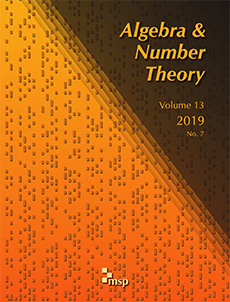Abstract
We sharpen earlier work (2011) of the first author, Luca and Mulholland, showing that the Diophantine equation
has, for “most” primes and suitably large prime exponents , no solutions. We handle a number of (presumably infinite) families where no such conclusion was hitherto known. Through further application of certain symplectic criteria, we are able to make some conditional statements about still more values of ; a sample such result is that, for all but primes up to , the equation
has no solutions in coprime, nonzero integers , and , for a positive proportion of prime exponents .
Citation
Michael A. Bennett. Carmen Bruni. Nuno Freitas. "Sums of two cubes as twisted perfect powers, revisited." Algebra Number Theory 12 (4) 959 - 999, 2018. https://doi.org/10.2140/ant.2018.12.959
Information





